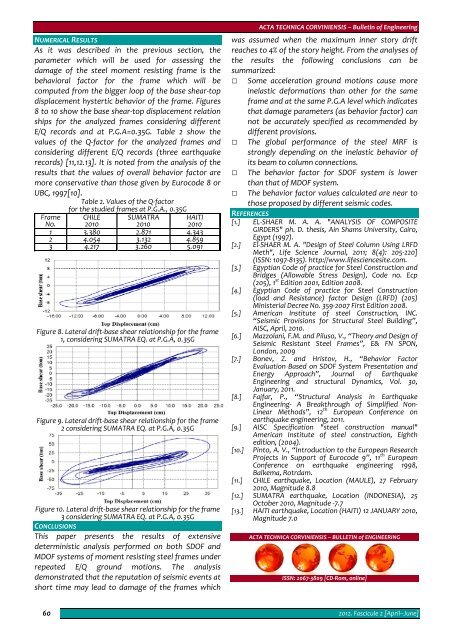Editorial & Advisory Board - Acta Technica Corviniensis
Editorial & Advisory Board - Acta Technica Corviniensis
Editorial & Advisory Board - Acta Technica Corviniensis
Create successful ePaper yourself
Turn your PDF publications into a flip-book with our unique Google optimized e-Paper software.
NUMERICAL RESULTS<br />
As it was described in the previous section, the<br />
parameter which will be used for assessing the<br />
damage of the steel moment resisting frame is the<br />
behavioral factor for the frame which will be<br />
computed from the bigger loop of the base shear‐top<br />
displacement hystertic behavior of the frame. Figures<br />
8 to 10 show the base shear‐top displacement relation<br />
ships for the analyzed frames considering different<br />
E/Q records and at P.G.A=0.35G. Table 2 show the<br />
values of the Q‐factor for the analyzed frames and<br />
considering different E/Q records (three earthquake<br />
records) [11,12.13]. It is noted from the analysis of the<br />
results that the values of overall behavior factor are<br />
more conservative than those given by Eurocode 8 or<br />
UBC, 1997[10].<br />
Table 2. Values of the Q‐factor<br />
for the studied frames at P.G.A., 0.35G<br />
Frame<br />
No.<br />
CHILE SUMATRA HAITI<br />
2010 2010 2010<br />
1 3.380 2.871 4.343<br />
2 4.054 3.132 4.859<br />
3 4.217 3.260 5.091<br />
Figure 8. Lateral drift‐base shear relationship for the frame<br />
1, considering SUMATRA EQ. at P.G.A, 0.35G<br />
Figure 9. Lateral drift‐base shear relationship for the frame<br />
2 considering SUMATRA EQ. at P.G.A, 0.35G<br />
Figure 10. Lateral drift‐base shear relationship for the frame<br />
3 considering SUMATRA EQ. at P.G.A, 0.35G<br />
CONCLUSIONS<br />
This paper presents the results of extensive<br />
deterministic analysis performed on both SDOF and<br />
MDOF systems of moment resisting steel frames under<br />
repeated E/Q ground motions. The analysis<br />
demonstrated that the reputation of seismic events at<br />
short time may lead to damage of the frames which<br />
ACTA TECHNICA CORVINIENSIS – Bulletin of Engineering<br />
was assumed when the maximum inner story drift<br />
reaches to 4% of the story height. From the analyses of<br />
the results the following conclusions can be<br />
summarized:<br />
Some acceleration ground motions cause more<br />
inelastic deformations than other for the same<br />
frame and at the same P.G.A level which indicates<br />
that damage parameters (as behavior factor) can<br />
not be accurately specified as recommended by<br />
different provisions.<br />
The global performance of the steel MRF is<br />
strongly depending on the inelastic behavior of<br />
its beam to column connections.<br />
The behavior factor for SDOF system is lower<br />
than that of MDOF system.<br />
The behavior factor values calculated are near to<br />
those proposed by different seismic codes.<br />
REFERENCES<br />
[1.] EL‐SHAER M. A. A. "ANALYSIS OF COMPOSITE<br />
GIRDERS" ph. D. thesis, Ain Shams University, Cairo,<br />
Egypt (1997).<br />
[2.] El‐SHAER M. A. "Design of Steel Column Using LRFD<br />
Meth", Life Science Journal, 2011; 8(4): 205‐220]<br />
(ISSN: 1097‐8135). http://www.lifesciencesite.com.<br />
[3.] Egyptian Code of practice for Steel Construction and<br />
Bridges (Allowable Stress Design), Code no. Ecp<br />
(205), 1 st Edition 2001, Edition 2008.<br />
[4.] Egyptian Code of practice for Steel Construction<br />
(load and Resistance) factor Design (LRFD) (205)<br />
Ministerial Decree No. 359‐2007 First Edition 2008.<br />
[5.] American Institute of steel Construction, INC.<br />
“Seismic Provisions for Structural Steel Building”,<br />
AISC, April, 2010.<br />
[6.] Mazzolani, F.M. and Piluso, V., “Theory and Design of<br />
Seismic Resistant Steel Frames”, E& FN SPON,<br />
London, 2009<br />
[7.] Bonev, Z. and Hristov, H., “Behavior Factor<br />
Evaluation Based on SDOF System Presentation and<br />
Energy Approach”, Journal of Earthquake<br />
Engineering and structural Dynamics, Vol. 30,<br />
January, 2011.<br />
[8.] Fajfar, P., “Structural Analysis in Earthquake<br />
Engineering‐ A Breakthrough of Simplified Non‐<br />
Linear Methods”, 12 th European Conference on<br />
earthquake engineering, 2011.<br />
[9.] AISC Specification "steel construction manual"<br />
American Institute of steel construction, Eighth<br />
edition, (2004).<br />
[10.] Pinto, A. V., “Introduction to the European Research<br />
Projects in Support of Eurocode 9”, 11 th European<br />
Conference on earthquake engineering 1998,<br />
Balkema, Rotrdam.<br />
[11.] CHILE earthquake, Location (MAULE), 27 February<br />
2010, Magnitude 8.8<br />
[12.] SUMATRA earthquake, Location (INDONESIA), 25<br />
October 2010, Magnitude ‐7.7<br />
[13.] HAITI earthquake, Location (HAITI) 12 JANUARY 2010,<br />
Magnitude 7.0<br />
ACTA TECHNICA CORVINIENSIS – BULLETIN of ENGINEERING<br />
ISSN: 2067‐3809 [CD‐Rom, online]<br />
60<br />
2012. Fascicule 2 [April–June]

















